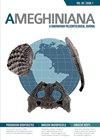New Miocene–Pliocene Specimens of Toxodontidae (Notoungulata) from the Huayquerías of Mendoza, West-Central Argentina
IF 1.5
4区 地球科学
Q3 PALEONTOLOGY
引用次数: 0
Abstract
Abstract. We describe three new Toxodontidae (Notoungulata) remains from Mendoza Province, west-central Argentina. One is a new mandible (IANIGLA-PV 993) collected at Huayquerías del Este, from the Huayquerías Formation (Late Miocene–earliest Pliocene). This finding adds to two other unpublished specimens from the area stored in old collections. MCNAM-PV 113 is a skull fragment from Huayquerías de San Carlos, lacking exact origin data, and MACN PV 14854 corresponds to associated upper and lower teeth from the so-called Bajada Grande locality, in Huayquerías del Este, from levels now assigned to the Bajada Grande Formation (Late Pliocene–Pleistocene). IANIGLA-PV 993 and MCNAM-PV 113 belong to Xotodon major. This species was described in 1914 based on cranial remains likely from levels now assigned to the Tunuyán Formation. Slight differences between IANIGLA-PV 993 and the holotype of X. major are attributable to intraspecific variation and their ontogenetic stage: smoother anteroventral mandibular angle; ascending ramus with blunt crest between the fossae for the zygomaticomandibularis and masseteric muscles; and tooth features (e.g., p4 with deeper grooves and slightly shorter teeth) that relate to a lesser wear degree. MCNAM-PV 113 shows nasals and upper teeth comparable with the holotype, although teeth are slightly less compressed. The temporal gap between levels yielding the holotype and IANIGLA-PV 993 is not reflected by our taxonomical interpretation. Finally, the specimen MACN PV 14854 is identified as Toxodon chapalmalensis, based upon its similarities with specimens from the Chapadmalal area, Buenos Aires Province, showing a correspondence with the Chapadmalalan Stage/Age of the Pampean Region. Resumen. Se describen tres restos de Toxodontidae (Notoungulata) de Mendoza, centro-oeste de Argentina. La mandíbula IANIGLA-PV 993 procede de la Formación Huayquerías (Mioceno Tardío-Plioceno más temprano) en las Huayquerías del Este. Éste se suma a dos especímenes inéditos del área pertenecientes a colecciones antiguas. MCNAM-PV 113 es un fragmento craneal de las Huayquerías de San Carlos, sin datos precisos de procedencia, y MACN PV 14854 incluye dentición superior e inferior asociada, colectada en la localidad Bajada Grande, Huayquerías del Este, en niveles asignados a la Formación Bajada Grande (Plioceno Tardío–Pleistoceno). IANIGLA-PV 993 y MCNAM-PV 113 pertenecen a Xotodon major. Esta especie se describió en 1914 a partir de restos craneales probablemente de niveles hoy asignados a la Formación Tunuyán. Las pequeñas diferencias entre IANIGLA-PV 993 y el holotipo de X. major son atribuibles a variación intraespecífica y los respectivos estados ontogenéticos: ángulo anteroventral mandibular más suave; rama ascendente con cresta roma entre las fosas para los músculos cigomático-mandibular y masetero; y rasgos dentarios (e.g., surcos más profundos en p4, dientes ligeramente más cortos) relacionados con el menor grado de desgaste. MCNAM-PV 113 muestra los nasales y la dentición comparables al holotipo, algo menos comprimidos los dientes. El lapso temporal entre los niveles de donde proceden el holotipo y el espécimen IANIGLA-PV 993 no se refleja en nuestra interpretación taxonómica. Finalmente, MACN PV 14854 se identifica como Toxodon chapalmalensis por sus semejanzas con ejemplares del área de Chapadmalal, provincia de Buenos Aires, mostrando una correspondencia con el Piso/Edad Chapadmalalense de la Región Pampeana.阿根廷中西部门多萨Huayquerías中新世-上新世弓形虫科新标本
摘要我们描述了来自阿根廷中西部门多萨省的三个新的弓形虫科(Notoungulata)遗骸。一个是在Huayquerías del Este收集的一个新的下颌骨(IANIGLA-PV 993),来自Huayquerías组(晚中新世-上新世早期)。这一发现增加了另外两个未发表的标本,这些标本来自该地区,保存在旧收藏中。MCNAM-PV 113是来自Huayquerías de San Carlos的头骨碎片,缺乏确切的起源数据,而MACN PV 14854对应的是来自Huayquerías del Este所谓的Bajada Grande地区的相关上下牙齿,现在属于Bajada Grande组(晚上新世-更新世)。IANIGLA-PV 993和MCNAM-PV 113属于Xotodon专业。这个物种是在1914年根据头盖骨被描述的,可能来自现在分配给Tunuyán组的水平。IANIGLA-PV 993与X. major全型之间的微小差异可归因于种内变异及其个体发生阶段:下颌前腹角平滑;在颧下颌肌和咬肌窝之间有钝嵴的升支;与较小磨损程度相关的齿特征(例如,具有较深凹槽和稍短齿的p4)。MCNAM-PV 113显示鼻部和上牙与全模相当,尽管牙齿稍微少一些压缩。产生完整型和IANIGLA-PV 993的水平之间的时间差距没有反映在我们的分类解释中。最后,根据MACN PV 14854标本与布宜诺斯艾利斯Chapadmalal地区标本的相似性,确定其为chapadmalensis,显示其与Pampean地区的Chapadmalalan阶段/年龄相对应。Resumen。他们描述了阿根廷中部门多萨的弓形虫科(Notoungulata)树。La mandíbula IANIGLA-PV 993程序de La Formación Huayquerías (Mioceno Tardío-Plioceno más temprano) en las Huayquerías del Este。Éste se suma a DOS especímenes insamdios del área pertencientes a collecciones antiguas。MACN -PV 14854包括dentición superior e inferior associada, collectada en la localidad Bajada Grande, Huayquerías del Este, en niveles asignados a la Formación Bajada Grande (Plioceno Tardío-Pleistoceno)。IANIGLA-PV 993和MCNAM-PV 113 % xtodon专业。尤其要注意describió 1914年,有一部分人恢复了他们的能力,可能是由于他们的能力,而不是因为他们的能力。Las pequeñas差异研究中心IANIGLA-PV 993和el holotipo de X.主要原因和variación intraespecífica分别为肿瘤组织:ángulo前腹侧下颌más suave;Rama ascendene con cresta roma entre las fosas para los músculos cigomático-mandibular y mastero;Y rasgos dentarios(例如,surcos más profundos en p4, dientes ligeramente más cortos)关系conel menmenor grado de desgaste。MCNAM-PV - 113的数据集与数据库的数据集(dentición)具有可比性。El lapso temporal entres los niveles de donde程序El holotitipoi - ppv993 no se refleja en nuestra interpretación taxonómica。最后,MACN PV 14854 se identiica comodon chapalmalensis por sus semejanzas con ejemplares del área de Chapadmalal, province de Buenos Aires, mostrando una correspondencia con el Piso/Edad Chapadmalalense de la Región Pampeana。
本文章由计算机程序翻译,如有差异,请以英文原文为准。
求助全文
约1分钟内获得全文
求助全文
来源期刊

Ameghiniana
地学-古生物学
CiteScore
2.50
自引率
10.00%
发文量
21
期刊介绍:
Ameghiniana is a bimonthly journal that publishes original contributions on all disciplines related to paleontology, with a special focus on the paleontology of Gondwana and the biotic history of the southern hemisphere. Published yearly since 1957, it has undoubtedly become the main palaeontological publication from Latin America. Ameghiniana has recently broadened its editorial board, reorganized its production process, and increased to a bimonthly frequency, which resulted in a significant decrease in the turn around time.
 求助内容:
求助内容: 应助结果提醒方式:
应助结果提醒方式:


